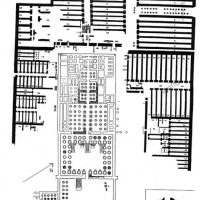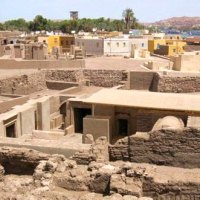Several items have recently been published or republished on botanical topics relating to ancient Egypt. I post them below together with links for ordering. They are all quite good.
The last 5 items are available on academia.edu and if you’re not a member you’ll have to join to gain access (it’s free and an excellent resource).
Bibliography on the Plants of Egypt and Related Subjects. The best bibliography on the subject ever compiled. An indispensable tool for whoever is involved …
The present study aims to provide Egyptologists and researchers interested in the plant of ancient Egypt with an adequate tool to orientate or update themselves in the increasingly numerous publications on this fascinating field.
010 – Flora [General]: 011 – Ecology 012 – Archaeobotanical reports 020 – Flora [by species]: 030 – Agriculture and hunting-gathering 040 – Gardening 050 – Food: 051 – Viticulture & viniculture 052 – Bread 053 – Beer 060 – Materials [General]: 061 – Papyrus 062 – Textiles 063 – Resins 064 – Wood 065 – Garlands and bouquets 066 – Basketry,ropes and shoes 067 – Inks 068 – Pigments & dyes 069 – Oils & fats 070 – medicine 080 – Poisons and drugs 090 – Perfumes and cosmetics 100 – Varia 101 – Aphrodisiacs 102 – Magic and cult 103 – Trade and explorationThe bibliography has been assembled by the staff of the Armenian Egyptology Centre, of which the plant world of ancient Egypt is one of the two main specialisations.
£ 100 including free P&P
Codex of Ancient Egyptian Plant Remains
The second revised and extended edition of the Codex of Ancient Egyptian Plant Remains is now available for order online from the publisher at Sais Books.
- Over 5300 identifications of ancient Egyptian plant remains.
- Shortlist to species identifications.
- Taxonomical classification of identified species in the manner of a flora.
- Comparative analysis with modern Egyptian flora.
- Index of common names.
- Most complete bibliography ever published on the subject.
- Introduction and analysis in English-French.
- Bibliography of over 400 archaeobotanical reports
£ 85 (€ 100) + P&P
ISBN 0-9527827-0-7
The study and analysis of plant material hitherto previously unknown from the Tutankhamun’s grave ultimately leading to the first scientific virtual reconstruction of an ancient Egyptian landscape and one standing to date alone in the field of Egyptian archaeobotany/Egyptology.
This is the Ph.D. research of Dr. C. T. de Vartavan, realized in University College London from 1988 to 1994 following his discovery of the Tutankhamun plant remains the Royal Botanical Gardens in Kew (UK). Discovery which made the upper part of page one of The Times (London, 19th of May 1988) ) and in the following days world press with articles in the Washington Post and nearly all major world newspapers, as well as television and radio.
First published in 1999. SECOND EDITION (2002) with color plates – 221 pages + 45 plates. 28.5 x 19 x 2 cm., paperback. 376 photographs (color and black and white) of the plant remains. 35 tables, 2 maps, 45 figures and 8 plates in the text, one in color. This 2012 reprint of the second edition comes with a CD of the above color plates .
£85 (= € 100 – depending on exchange rate) including free P&P
Pistacia species in relation to their use as varnish and ‘incense’ (sntr) in pharaonic Egypt

Pistacia species, Nile valley, and in hieroglyphs – source: de Vartavan
Abstract: Chemical analyses of ancient Pistacia resins found in pharaonic contexts have so far failed to go beyond the genus level, to reach the species level. This failure hinders the identification of the precise identity of the Pistacia species brought during this period to the Nile Valley, and the subsequent historical and economic conclusions which would result from such exact identifications particularly in relation to foreign trade. The general purpose of the present study is to synthesize the current state of research so as to stimulate the future solving of this problem…
A note concerning a new way to build a ‘seed’ reference collection, by Christian de Vartavan
A brief review of methods of storing reference material of ‘seeds’ is given, with adescription of a novel system that is readily transportable … I should like to describe a new system for those who do not wish to struggle with jungles of densely-packed glass tubes; this is the recipe …
The representativeness of the archaeobotanical archive in the example of Roman Karanis, Fayum Egypt, Frederica Fantone.
The informative potential of the archaeobotanical archive can be extremely high for example to reconstruct the former diet or vegetation. Nevertheless no direct link can be established between what the record directly shows and what it indirectly represents. The representativeness of the archaeobotanical archive depends on the processes that may introduce bias in the botanical composition and on the accuracy of the reconstructions. Among these processes sampling plays a crucial role.
In recent excavations in the north eastern sector of Roman Karanis (Egypt) a sampling strategy that combines systematic on-field-sieving and judgment sampling has been implemented. A comparison between the two methods has been carried out. The main aim is to estimate their potential in providing the researcher with effective tools to distinguish the components of the record and to answer specific questions. The analysis has shown to what extent context-related variations in the composition and distribution of plant remains may be due to the adopted sampling method. Moreover, the evaluation of the hand-picked samples has shown potential and limits of this type of samples which is in general ignored in archaeobotanical reports …
An investigation of taphonomical processes by means of digital image analysis of Phoenix dactylifera seeds from Roman Karanis, Frederica Fantone
The analysis of taphonomical processes such as disposal patterns and contamination are important issues for the representativeness of the archaeobotanical record; they may be complicated by the indigenous character of species consistently represented in the data set. Measurements of sub-fossil seeds of Date palm (Phoenix dactylifera) have moslty been applied to the identification of different varieties. The question is: can they be used to infer taphonomical processes? In an attempt to answer this question, digital image analysis was performend on photographs of 2730 sub-fossil Date palm seeds from Roman Karanis. The results have been used to investigate processes of dispersal, mixing and reducing by taking into account the possible action of both biotic and abiotc factors.
Archaeological evidence for the infection of barley (Ustilago hordei) has been found in the form of infected rachis fragments in the Roman sites of Berenike and Shenshef in Egypt. Further records of this plant disease relate to the sites of Roman Karanis and the Roman and Islamic ports at Quseir Al-Qadim. However, the recent discovery of Ustilago hordei on charred barley remains from Tell Dayr Alla in Jordan shows that the fungus was already present in the Southern Levant during the Iron Age.
- The penultimate Pharaoh of Ancient Egypt’s*** Ay*** (cardsmall.wordpress.com)
- Ancient Egyptian Tomb Scenes – Villagers’ Perspectives (dianabuja.wordpress.com)
- Mummies Study Reveals That Hardening Of The Arteries May Have Been A Global Problem In The Ancient World (medicalnewstoday.com)




























Pingback: Agriculture; Livestock; Indigenous Plants; Agroforestry – Links | DIANABUJA'S BLOG: Africa, the Middle East, Agriculture, History & Culture
Pingback: Vinegar in Ancient Egypt: Sour Wine or Tasty Condiment? | DIANABUJA'S BLOG
Pingback: Modern Words that Survive from Ancient Egypt – What, How and Why | DIANABUJA'S BLOG
Pingback: Frédéric Cailliaud: Eighteenth Century French Scientist and Explorer in Egypt | DIANABUJA'S BLOG
Pingback: Nibbles: Heirloom conference, Saving plants, Aquaculture benefits, Ancient Egyptian botany, Coffee blogs, ITPGRFA, GIAH